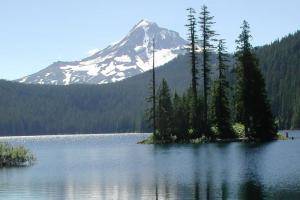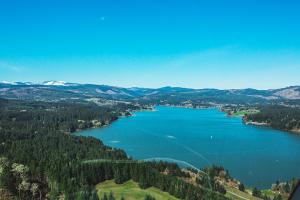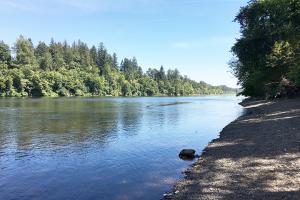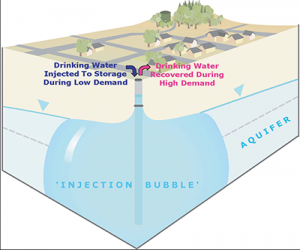FAQs
Water System and Sources
-
Portland Water Bureau
 TVWD receives about 72% of its water from the Portland Water Bureau. Portland water primarily comes from the Bull Run watershed and is piped to a 50-million gallon storage reservoir on Powell Butte, located on the east side of Portland. Currently, chlorine and ammonia are added to the water to disinfect it to meet federal drinking water standards. It is also adjusted for pH to make the water less corrosive to pipes.
TVWD receives about 72% of its water from the Portland Water Bureau. Portland water primarily comes from the Bull Run watershed and is piped to a 50-million gallon storage reservoir on Powell Butte, located on the east side of Portland. Currently, chlorine and ammonia are added to the water to disinfect it to meet federal drinking water standards. It is also adjusted for pH to make the water less corrosive to pipes.The Portland Water Bureau also uses the Columbia South Shore Wellfield to augment the Bull Run supply. Drawn from 25 wells and four aquifers, it is capable of producing close to 100 million gallons per day (MGD).
Tualatin Valley Water District will transition off this supply in 2026, when the Willamette Water Supply System is operational. An emergency connection will remain in the event of a regional water emergency, agencies will share water with one another.
-
Joint Water Commission
 About 28% of water comes from the Joint Water Commission (JWC), which is jointly owned by TVWD and the Cities of Hillsboro, Beaverton and Forest Grove. The JWC source is comprised of water from Hagg Lake (Scoggins Reservoir) and the Barney Reservoir released into the upper portion of the Tualatin River. When flows are available, water from the Tualatin River is used. It is then withdrawn and filtered through the JWC water treatment plant. Chlorine and pH adjustments are added before leaving the plant.
About 28% of water comes from the Joint Water Commission (JWC), which is jointly owned by TVWD and the Cities of Hillsboro, Beaverton and Forest Grove. The JWC source is comprised of water from Hagg Lake (Scoggins Reservoir) and the Barney Reservoir released into the upper portion of the Tualatin River. When flows are available, water from the Tualatin River is used. It is then withdrawn and filtered through the JWC water treatment plant. Chlorine and pH adjustments are added before leaving the plant.Each owner has a different amount invested in different parts of the JWC system, with TVWD's portion consisting of storage in Barney Reservoir.
Tualatin Valley Water District will continue to own and use a share of the JWC supply after 2026, when the the Willamette Water Supply System is operational.
-
Willamette Water Supply Program
 Tualatin Valley Water District, the City of Hillsboro, and the City of Beaverton have partnered to form the Willamette Water Supply Program, an effort to access water from the Willamette River at Wilsonville as an additional regional water supply source. This new, reliable water supply for Washington County is on-schedule to deliver drinking water to more than 300,000 Washington County residents and businesses in 2026.
Tualatin Valley Water District, the City of Hillsboro, and the City of Beaverton have partnered to form the Willamette Water Supply Program, an effort to access water from the Willamette River at Wilsonville as an additional regional water supply source. This new, reliable water supply for Washington County is on-schedule to deliver drinking water to more than 300,000 Washington County residents and businesses in 2026.Learn more at OurReliableWater.org.
-
Is there sewage in the Willamette River?
The Willamette is an excellent drinking water source that has been used by the City of Wilsonville and the City of Sherwood since 2002. Untreated sewage spills upriver from the intake facility in Wilsonville are extremely rare. They are more common downriver from the intake near downtown Portland, which is below Willamette Falls in Oregon City. Willamette Falls serves as a natural barrier keeping contaminants from downtown Portland from the drinking water intake facility. TVWD has several water sources, which would enable us to switch to another source in event of any contaminant in one single source. The treatment plant, which is being constructed within the Willamette Water Supply System, will have multiple treatment options that are capable of produced high quality drinking water for customers.
-
Grabhorn Aquifer Storage and Recovery
 During the winter, when water supplies are plentiful, TVWD stores treated drinking water underground in the aquifer surrounding the Grabhorn Aquifer Storage and Recovery (ASR) well. During the summer, the stored water is pumped out of the well to augment other sources to help meet peak-summer water demands. This ASR is able to supply our District with 3 million gallons a day for approximately 90-100 days.
During the winter, when water supplies are plentiful, TVWD stores treated drinking water underground in the aquifer surrounding the Grabhorn Aquifer Storage and Recovery (ASR) well. During the summer, the stored water is pumped out of the well to augment other sources to help meet peak-summer water demands. This ASR is able to supply our District with 3 million gallons a day for approximately 90-100 days.The Grabhorn ASR well is capable of storing in excess of 350 MG of treated water. In comparison, the combined total capacity of TVWD's existing 23 storage reservoirs is about 67 MG. This seasonal supply helps meet peak-summer water demands and reduce the District's cost for purchased water.
During the 2020 fiscal year, TVWD injected about 74 million gallons of water in to the ASR, and withdrew about 18 million gallons from the ASR.

